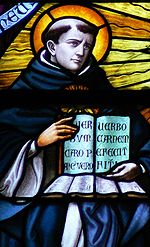- Decretum Gratiani
-

This article is part of a series on the
Law of the Catholic ChurchCodes of Canon Law
- 1983 Code of Canon Law
- Code of Canons of the Eastern Churches
- 1917 Code of Canon Law
- Concordance of Discordant Canons
- Decretals of Gregory IX
- Anglicanorum Coetibus
- Benedictus Deus
- Ex Corde Ecclesiae
- Fidei Depositum
- Indulgentiarum Doctrina
- Pastor Bonus
- Providentissima Mater Ecclesia
- Sacrae Disciplinae Leges
- Ut Sit (see also Opus Dei)
- Universi Dominici Gregis
Canon Law of Vatican II
Other
- Canon 915
- Latae Sententiae Excommunication
- Motu Proprio
· WikiProject Canon Law
The Decretum Gratiani or Concordia discordantium canonum (in some manuscripts Concordantia discordantium canonum) is a collection of Canon law compiled and written in the 12th century as a legal textbook by the jurist known as Gratian. It forms the first part of the collection of six legal texts, which together became known as the Corpus Juris Canonici. It retained legal force in the Roman Catholic Church until Pentecost 1918, when a revised Code of Canon Law (Codex Iuris Canonici) promulgated by Pope Benedict XV on 27 May 1917 obtained the Force of Law[1].
Contents
Recensions
Research by Anders Winroth shows that the Decretum existed in two published recensions.[2] The first dates to some time after 1139, while the second dates to 1150 at the latest. There are several major differences between the two recensions:
- The first recension is a more coherent and analytical work.
- The second recension places a much greater emphasis on papal primacy and power.
- The second recension includes Roman law extracts taken directly from the Corpus Juris Civilis, whereas the first recension does not demonstrate substantial familiarity with Roman jurisprudence.
These differences led Winroth to conclude that Roman law was not as far developed by 1140 as scholars had previously thought. He has also argued that the second recension was due not to the original author of the first recension (whom he calls Gratian 1), but rather another jurist versed in Roman law.[3] However, Winroth's thesis of two Gratians remains controversial.[citation needed]
This field of inquiry is hampered by ignorance of the compiler's identity and the existence of manuscripts with abbreviated versions of the text or variant versions not represented by Winroth's two recensions. One of these is the manuscript St. Gall, Stiftsbibliothek, 673 (=Sg), which some have argued contains the earliest known version (borrador) of the Decretum,[4] but which other scholars have argued contains an abbreviation of the first recension expanded with texts taken from the second recension.[5]
Gratian's sources
Gratian's sources were Roman law, the Bible, the writings of (or attributed to) the Church Fathers, papal decretals, the acts of church councils and synods. In most cases, Gratian did not obtain this material from a direct reading of the sources, but rather through intermediate collections. Thanks to the research of modern scholars - in particular, Charles Munier, Titus Lenherr, and Peter Landau - we now know that Gratian made use of a relatively small number of collections in the composition of most of the Decretum, these being:
- Anselm (II) of Lucca’s canonical collection, originally compiled around 1083 and existing in four main recensions: A, B, Bb, and C. Peter Landau suggests that Gratian probably employed a manuscript containing an expanded form of recension A which he calls recension A’;
- the Collectio tripartita attributed to Ivo of Chartres, usually thought to date to 1095;
- the Panormia of Ivo of Chartres, also usually dated to 1095, although several scholars have argued for a later date and some even question Ivo's authorship;
- Gregory of St. Grisogono's Polycarpus, completed some time after 1111;
- the Collection in Three Books, composed some time between 1111 and 1139, though dated by some to around 1123;
- the Glossa ordinaria to the Bible.
Other sources are known to have been used in the composition of particular sections of the Decretum:
- Isidore of Seville's Etymologies for DD. 1-9 (the so-called Treatise on Laws);
- Alger of Liège's Liber de misericordia et iustitia for C. 1;
- the Sententiae magistri A. for the De penitentia and some other sections.
Effect
Gratian himself named his work Concordia Discordantium Canonum - "Concord of Discordant Canons." The name is fitting: Gratian tried to harmonize apparently contradictory canons with each other, by discussing different interpretations and deciding on a solution. This dialectical approach allowed for other law professors to work with the Decretum and to develop their own solutions and commentaries. These legalists are known as the decretists.
These commentaries were called glosses. Editions printed in the 15th, 16th or 17th centuries frequently included the glosses along with the text. Collections of glosses were called "gloss apparatus" or Lectura in Decretum (see also glossator). Systematic commentaries were called Summae. Some of these Summae were soon in circulation as well and obtained the same level of fame as the Decretum itself. Early commentators included Paucapalea and Magister Rolandus.
The most important commentators were probably Rufin of Bologna (died before 1192) and Huguccio (died 1210). Less well-known was the commentary of Simon of Bisignano, which consisted of the Glosses on the Decretum and the Summa Simonis.
Citations
- ^ Ap. Const. Providentissima Mater Ecclesia (by Pope Benedict XV, 27 May 1917)
- ^ Anders Winroth, The Making of Gratian's Decretum (Cambridge, 2000)
- ^ Ibid., 146-74
- ^ Carlos Larrainzar, ‘El borrador de la “Concordia” de Graciano: Sankt Gallen, Stiftsbibliothek MS 673 (=Sg)’, Ius Ecclesiae: Rivista internazionale di diritto canonico 11 (1999): 593-666
- ^ Titus Lenherr, "Ist die Handschrift 673 der St. Galler Stiftsbibliothek (Sg) der Entwurf zu Gratians Dekret?: Versuch einer Antwort aus Beobachtungen an D.31 und D.32" (unpublished paper); Anders Winroth, “Recent Work on the Making of Gratian’s Decretum,” Bulletin of Medieval Canon Law, n.s. 26 (2004-2006): 1-29; John Wei, “A Reconsideration of St. Gall, Stiftsbibliothek 673 (Sg) in light of the Sources of Distinctions 5-7 of the De penitentia,” Bulletin of Medieval Canon Law, n.s. 27 (2007): 141-80.
References
- Landau, Peter. "Gratians Arbeitsplan." In Iuri canonico promovendo: Festschrift für Heribert Schmitz zum 65. Geburtstag. Regensburg: F. Pustet, 1994. pp. 691-707.
- Landau, Peter. "Neue Forschungen zu vorgratianischen Kanonessammlungen und den Quellen des gratianischen Dekrets." Ius Commune 11 (1984): 1-29. Reprinted in idem. Kanones und Dekretalen. pp. 177*-205*
- Landau, Peter. "Quellen und Bedeutung des gratianischen Dekrets," Studia et Documenta Historiae et Juris 52 (1986): 218-235. Reprinted in idem. Kanones und Dekretalen. pp. 207*-224*.
- Lenherr, Titus. Die Exkommunikations- und Depositionsgewalt der Häretiker bei Gratian und den Dekretisten bis zur Glossa ordinaria des Johannes Teutonicus. St. Ottilien: EOS Verlag, 1987.
- Munier, Charles. Les sources patristiques du droit de l’église du VIIIe au XIIIe siècle. Mulhouse 1957.
- Noonan, John T. "Gratian slept here: the changing identity of the father of the systematic study of canon law." Traditio 35 (1979), 145-172.
- Winroth, Anders. The Making of Gratian's Decretum. New York: Cambridge University Press, 2000.
- Winroth, Anders. "Recent Work on the Making of Gratian's Decretum," Bulletin of Medieval Canon Law 26 (2008).
External links
- Full Latin text from the Bayerische Staatsbibliothek
- Otto Vervaart's introduction to Canon Law
- Domus Gratiani
- The Stephan Kuttner Institute of Medieval Canon Law in Munich
History of the Catholic Church General History of the Catholic Church · History of the Papacy · History of the Roman Curia · Catholic Ecumenical Councils · Timeline of the Catholic Church · History of Christianity · Role of the Catholic Church in Western civilization · Art in Roman Catholicism · Catholic religious order · Christian monasticism · Papal States
Church beginnings Constantine the Great to
Pope Gregory IConstantine the Great and Christianity · Arianism · Basilica of St. John Lateran · First Council of Nicaea · Pope Sylvester I · First Council of Constantinople · Biblical canon · Jerome · Vulgate · First Council of Ephesus · Council of Chalcedon · Benedict of Nursia · Second Council of Constantinople · Pope Gregory I · Gregorian chant
Early Middle Ages Third Council of Constantinople · Saint Boniface · Byzantine Iconoclasm · Second Council of Nicaea · Charlemagne · Pope Leo III · Fourth Council of Constantinople · East–West Schism
High Middle Ages Pope Urban II · Investiture Controversy · Crusades · First Council of the Lateran · Second Council of the Lateran · Third Council of the Lateran · Pope Innocent III · Latin Empire · Francis of Assisi · Fourth Council of the Lateran · Inquisition · First Council of Lyon · Second Council of Lyon · Bernard of Clairvaux · Thomas Aquinas
Late Middle Ages Protestant Reformation/
Counter-ReformationBaroque Period to the
French Revolution19th century Pope Pius VII · Pope Pius IX · Dogma of the Immaculate Conception of the Virgin Mary · Our Lady of La Salette · Our Lady of Lourdes · First Vatican Council · Papal infallibility · Pope Leo XIII · Mary of the Divine Heart · Prayer of Consecration to the Sacred Heart · Rerum Novarum
20th century Pope Pius X · Our Lady of Fátima · Persecutions of the Catholic Church and Pius XII · Pope Pius XII · Pope Pius XII Consecration to the Immaculate Heart of Mary · Dogma of the Assumption of the Virgin Mary · Pope John XXIII · Second Vatican Council · Pope Paul VI · Pope John Paul I · Pope John Paul II
21st century By country or region Brazil · Cuba · France · Germany · Hispano-America · Ireland · Japan · Mexico · Spain · United States · Venezuela
History of Catholic theology Theologians · Teachings · HeresiesGeneral History History of the Catholic Church · Early Christianity · History of the Papacy · Ecumenical Councils · Timeline of the Catholic Church · History of Christianity · History of Christian theology
Church beginnings First Epistle of Clement · Didache · Ignatius of Antioch · Epistle of Barnabas · Justin Martyr · Irenaeus · Tertullian · Origen · Antipope Novatian · CyprianConstantine to
Pope Gregory IEarly Middle Ages Monothelitism · Ecthesis · Iconoclasm · Transubstantiation dispute · Predestination disputes · John Scotus EriugenaHigh Middle Ages Thomas Aquinas · Thomism · Roscellinus · Anselm of Canterbury · Peter Abelard · Decretum Gratiani · Bernard of Clairvaux · Peter Lombard · Hildegard of Bingen · Dominic de Guzmán · Francis of Assisi · Bonaventure · Albertus MagnusMysticism & Reforms Protestant Reformation and
Counter-ReformationBaroque Period to
French RevolutionJacques-Bénigne Bossuet · Francisco Suárez · François Fénelon · Jansenism · Blaise Pascal · Alphonsus Maria de Liguori · Louis de Montfort · Alfonso Muzzarelli · Louis Thomassin · Jean de La Fontaine19th century 20th-21st century Categories:- High Middle Ages
- Canon law (Catholic Church)
- Medieval law
- Documents of the Catholic Church
- 12th-century medieval Latin literature
Wikimedia Foundation. 2010.


